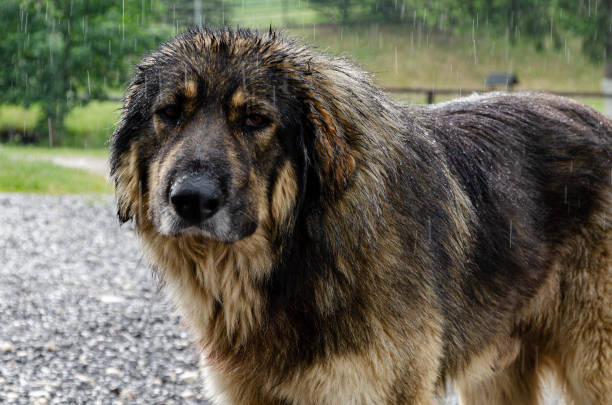Romanian Carpathian Shepherd

Breed History:
The Romanian Carpathian Shepherd Dog (Câine Ciobănesc Carpatin) is an ancient livestock guardian breed developed in the Carpathian Mountains of Romania. Used for centuries by Romanian shepherds, it was bred for its loyalty, courage, and resilience in protecting flocks from predators such as wolves and bears.
Though natural selection shaped much of its early development, formal breeding began in the 20th century, and the Romanian Kennel Club standardised the breed. It was officially recognised by the FCI (Fédération Cynologique Internationale) in 2015.
Still primarily used as a working dog in rural Romania, the Carpathian Shepherd is beginning to gain recognition in other countries for its noble temperament and dependable guardian instincts.
Considering adopting a Romanian Carpathian Shepherd or a similar flock guardian breed? Check out our page "How to look after a Kurdish Kangal" detailing what to consider before adopting and our recommended products for a Kurdish Kangal and other flock guardian breeds.
|
Gender |
Height |
Weight |
|
Male |
65-73 cm |
30-50 kg |
|
Female |
59-67 cm |
30-45 kg |
Size – Large
Life Expectancy: 12–14 years

Breed Appearance:
The Romanian Carpathian Shepherd Dog is a large, powerful, and well-balanced dog with a strong bone structure and an imposing, yet calm presence. It has a rectangular body, deep chest, and a broad head with a moderately long muzzle and well-developed jaws.
The coat is dense and straight, with a soft, thick undercoat. The outer coat is harsher and longer, especially around the neck, back of the thighs, and tail. Coat colour is typically wolf-grey with lighter markings on the underside and legs, mimicking the natural camouflage of wild canines.
The breed’s expression is serious and confident, with dark, almond-shaped eyes and medium-sized, triangular drop ears.
Breed Type – Guardian/Working:
Bred for livestock guarding, the Carpathian Shepherd is brave, loyal, and territorial. It forms strong bonds with its flock and human family, often placing itself between them and perceived threats.
Though not an aggressive breed by nature, it is naturally protective, reserved with strangers, and quick to act if danger is sensed. These instincts make it an excellent farm guardian and a watchdog, especially in rural or large property settings.
With proper socialisation and training, it is also a calm, gentle companion to its family, including children.

Training:
The Carpathian Shepherd is intelligent and eager to please, but it also possesses independent thinking developed over centuries of working without human direction. Training should begin early and focus on clear commands, boundaries, and trust-building.
This breed responds best to calm, confident leadership and positive reinforcement. Harsh corrections are counterproductive and may damage trust. Early socialisation is critical to ensure the dog is well-adjusted to new people, places, and other animals.
Though not suited for tricks or complex agility, it can excel in obedience, protection, and advanced guarding roles.
Health & Care:
The Romanian Carpathian Shepherd Dog is generally robust and healthy, with few inherited health problems, thanks to its strong working roots and limited crossbreeding.
Potential concerns include:
-
Hip dysplasia
-
Elbow dysplasia
-
Bloat (gastric torsion)
Routine health screenings, especially for hips and joints, are recommended for breeding dogs. Providing a balanced diet, joint supplements, and regular exercise helps maintain overall health. Their thick coat offers excellent protection but requires monitoring for parasites and overheating in warm climates.

Living Conditions:
This breed thrives in rural or semi-rural environments, ideally with space to roam, such as farms or large fenced yards. It is not well-suited to apartment living due to its size, energy, and guarding instincts.
The Carpathian Shepherd needs to feel useful and involved, whether guarding property, herding livestock, or accompanying family members on outdoor tasks. Without purpose, it may become bored, vocal, or territorial.
It prefers cooler climates and may struggle in hot or humid regions unless provided with shade, water, and rest.
Exercise:
While not hyperactive, the Carpathian Shepherd is a hardy, energetic breed that needs daily exercise and mental engagement. Long walks, hikes, or patrolling a property satisfy its physical and territorial instincts.
At least 60–90 minutes of daily activity is ideal. Boredom can lead to undesirable behaviours such as digging, barking, or fence testing, especially if left alone too long.
Due to its guarding nature, off-leash exercise should be in secure areas, as the dog may act independently if it feels its territory is threatened.
Grooming:
The breed’s double coat requires moderate grooming. Weekly brushing is sufficient for most of the year, though more frequent grooming is needed during seasonal shedding periods, typically in spring and fall.
Bathing should be occasional, only when dirty, as over-bathing can strip natural oils from the coat. Nail trimming, ear cleaning, and dental care are essential parts of routine maintenance.
Inspect the coat regularly for ticks, debris, or skin issues, especially after time in wooded or rural areas.

Advantages:
-
Loyal and deeply bonded with family
-
Excellent guardian for livestock and property
-
Calm and even-tempered with proper training
-
Low maintenance grooming needs for a long-coated breed
-
Highly resilient and adaptable to cold weather
-
Rarely aggressive without reason; naturally discerning
Disadvantages:
-
Needs space; not suitable for apartment life
-
Independent nature can challenge novice owners
-
Requires early and ongoing socialisation
-
Strong guarding instincts may lead to suspicion of strangers
-
Can become bored or destructive if under-stimulated
-
May not tolerate hot climates well due to a heavy coa

